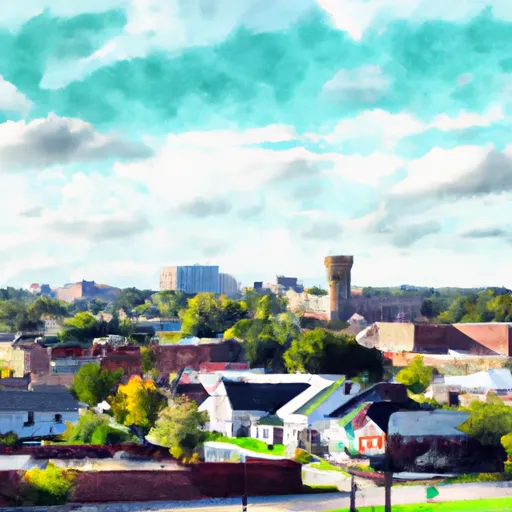-
 Snoflo Premium
Snoflo Premium
Get unlimited access to all our content
With no Ad interruptions! - Start Your Free Trial Login with existing account
Westfield
Eden Index
Climate
8.3
•
Recreation
3.4
•
Community
•
Safeguard
4.5/10

Westfield, Illinois is a small village located in Clark County. The climate in Westfield is characterized by warm summers and cold winters. Average temperatures range from the mid-80s°F (30°C) during summer to the mid-20s°F (-4°C) in winter. Precipitation is fairly evenly distributed throughout the year, with the wettest months being May and June.
Westfield is situated near several water bodies, including the Embarras River and Casey Fork Creek. These hydrological constituents provide locals and visitors with opportunities for various outdoor activities. Fishing enthusiasts can enjoy casting their lines for bass, catfish, and crappie in these waterways. Additionally, the nearby Lincoln Trail State Park offers hiking and camping options for those seeking to explore nature and enjoy the picturesque surroundings.
Westfield also hosts the annual Westfield Fair, where residents and visitors can experience traditional agricultural displays, livestock shows, carnival rides, and live entertainment. This event offers an opportunity to engage with the local community and enjoy festivities in a rural setting. Overall, Westfield's climate and hydrological constituents, coupled with its outdoor recreational opportunities, make it an appealing destination for nature lovers and those seeking a small-town experience.
What is the Eden Index?
The Snoflo Eden Index serves as a comprehensive rating system for regions, evaluating their desirability through a holistic assessment of climate health, outdoor recreation opportunities, and natural disaster risk, acknowledging the profound impact of these factors on livability and well-being.
Climate Health Indicator (CHI): 8.3
Westfield receives approximately
1066mm of rain per year,
with humidity levels near 81%
and air temperatures averaging around
12°C.
Westfield has a plant hardyness factor of
6, meaning
plants and agriculture in this region thrive during a short period during spring and early summer. Most
plants will die off during the colder winter months.
By considering the ideal temperature range, reliable water supplies, clean air, and stable seasonal rain or snowpacks, the Climate Health Indicator (CHI) underscores the significance of a healthy climate as the foundation for quality living.
A healthy climate is paramount for ensuring a high quality of life and livability in a region, fostering both physical well-being and environmental harmony. This can be characterized by ideal temperatures, reliable access to water supplies, clean air, and consistent seasonal rain or snowpacks.
Weather Forecast
Streamflow Conditions
Wabash
Area Rivers
Wabash
Snowpack Depths
Wabash
Reservoir Storage Capacity
Wabash
Groundwater Levels
Recreational Opportunity Index (ROI): 3.4
The Recreational Opportunity Index (ROI) recognizes the value of outdoor recreational options, such as parks, hiking trails, camping sites, and fishing spots, while acknowledging that climate plays a pivotal role in ensuring the comfort and consistency of these experiences.
Access to outdoor recreational opportunities, encompassing activities such as parks, hiking, camping, and fishing, is crucial for overall well-being, and the climate plays a pivotal role in enabling and enhancing these experiences, ensuring that individuals can engage in nature-based activities comfortably and consistently.
Camping Areas
| Campground | Campsites | Reservations | Toilets | Showers | Elevation |
|---|---|---|---|---|---|
| Gatlin Point - LBL | 19 | 453 ft | |||
| Piney - LBL | 300 | 385 ft | |||
| Beech Bend | None | 373 ft | |||
| Paris Landing State Park | 63 | 392 ft | |||
| Bumpus Mills - Lake Barkley | None | 520 ft | |||
| Mousetail Landing State Park | 24 | 429 ft | |||
| Nathan Bedford Forrest State Park | 53 | 437 ft | |||
| Rushing Creek - LBL | 56 | 402 ft | |||
| Gatlin Point | 30 | 433 ft | |||
| Boswell Landing | 34 | 406 ft |
Nearby Ski Areas
Catastrophe Safeguard Index (CSI):
The Catastrophe Safeguard Index (CSI) recognizes that natural disaster risk, encompassing floods, fires, hurricanes, and tornadoes, can drastically affect safety and the overall appeal of an area.
The level of natural disaster risk in a region significantly affects safety and the overall livability, with climate change amplifying these risks by potentially increasing the frequency and intensity of events like floods, fires, hurricanes, and tornadoes, thereby posing substantial challenges to community resilience and well-being.
Community Resilience Indicator (CRI):
The Community Resilience Indicator (CRI) recognizes that education, healthcare, and socioeconomics are crucial to the well-being of a region. The CRI acknowledges the profound impact of these elements on residents' overall quality of life. By evaluating educational resources, healthcare accessibility, and economic inclusivity, the index captures the essential aspects that contribute to a thriving community, fostering resident satisfaction, equity, and social cohesion.

